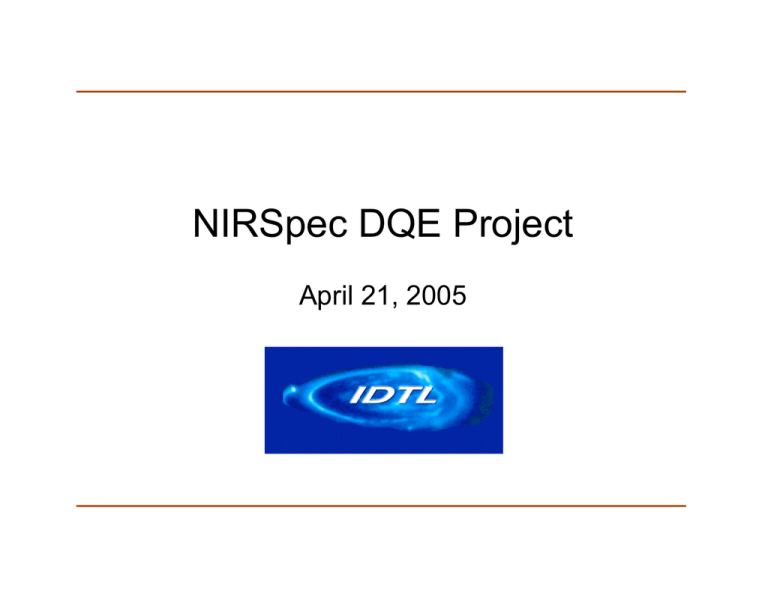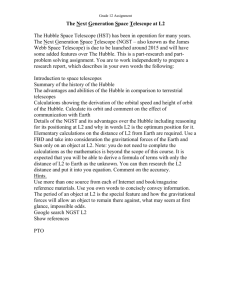NIRSpec DQE Project April 21, 2005
advertisement

NIRSpec DQE Project April 21, 2005 SPACE TELESCOPE SCIENCE INSTITUTE JAMES WEBB SPACE TELESCOPE Background • NIRSpec Project Office at GSFC requested the IDTL to measure DQE at one wavelength in the M-band. • IDTL accepted request and plans to make measurement in summer 2005. April 21, 2005 TIPS Presentation 2 SPACE TELESCOPE SCIENCE INSTITUTE JAMES WEBB SPACE TELESCOPE Definitions: QE • Quantum Efficiency (QE) is a measure of photogenerated charge as a fraction of incident photon flux. It can appear to be greater than 1 in devices with charge gain, i.e. photomultiplier tubes (g~106). QE = gh where h is the probability that an incident photon produced charge that was measured. April 21, 2005 TIPS Presentation 3 SPACE TELESCOPE SCIENCE INSTITUTE JAMES WEBB SPACE TELESCOPE Definitions: DQE • Detective Quantum Efficiency (DQE) is a measure of sensitivity. It cannot exceed 1. In the shot noise limited case, it is a measure of photogenerated events as a fraction of incident photon flux. Ï ( S / N ) measured ¸ DQE = Ì ˝ Ó ( S / N ) shot ˛ April 21, 2005 TIPS Presentation 2 4 SPACE TELESCOPE SCIENCE INSTITUTE JAMES WEBB SPACE TELESCOPE Definitions: DQE hFt Ï Ô 2 h Ft + n Ô r + idark t DQE = Ì Ft Ô ÔÓ Ft April 21, 2005 TIPS Presentation 2 ¸ Ô Ô shot noise limited æ ææææ æÆh. ˝ Ô Ô˛ 5 SPACE TELESCOPE SCIENCE INSTITUTE JAMES WEBB SPACE TELESCOPE When DQE=QE • For long wavelengths, i.e. l~ lcutoff, charge gain will be nearly 1. In this case, QE=DQE=h. April 21, 2005 TIPS Presentation 6 SPACE TELESCOPE SCIENCE INSTITUTE JAMES WEBB SPACE TELESCOPE NIRSpec DQE Project Goals 1. 2. 3. 4. Measure DQE at one wavelength near 5 mm for one NIRSpec prototype detector. Measure DQE at all wavelengths between 0.4 to 5.5 mm for one NIRSpec prototype detector. Perform IDTL full-suite testing on one NIRSpec prototype detector. Train STScI personnel in detector testing, data analysis, and lab procedures. April 21, 2005 TIPS Presentation 7 SPACE TELESCOPE SCIENCE INSTITUTE JAMES WEBB SPACE TELESCOPE Plan 1. 2. 3. 4. Measure gain (e-/ADU) using photon transfer experiment. Measure DQE by obtaining stacks of flats looking at calibrated cool blackbody with M-band filter in the beam. Repeat #2 using uncalibrated hot blackbody, calibrated diode, monochromator, integrating sphere, and order-sorting cutoff filters. Perform remaining IDTL tests, i.e. dark current, read noise, persistence, etc. April 21, 2005 TIPS Presentation 8 SPACE TELESCOPE SCIENCE INSTITUTE JAMES WEBB SPACE TELESCOPE Photon Transfer Experiment • Goal is to get conversion from ADU to electrons • Obtain stack of images at various exposure times under constant flux. Compute median variance for each exposure time. s 2 ADU s r2,e- hFt 1 Ê hFt ˆ 1 2 2 = 2 + = Á ˜ + s r , ADU = S ADU + s r , ADU . G G GË G ¯ G April 21, 2005 TIPS Presentation 9 SPACE TELESCOPE SCIENCE INSTITUTE JAMES WEBB SPACE TELESCOPE Photon Transfer Example April 21, 2005 TIPS Presentation 10 SPACE TELESCOPE SCIENCE INSTITUTE JAMES WEBB SPACE TELESCOPE QE Example charge gain neglected April 21, 2005 TIPS Presentation 11 JAMES WEBB SPACE TELESCOPE SPACE TELESCOPE SCIENCE INSTITUTE Spectral Flat Fields near 1 mm fringing 12 SPACE TELESCOPE SCIENCE INSTITUTE JAMES WEBB SPACE TELESCOPE Si PIN QE versus Wavelength 100% 90% 140 K 160 K 180 K 200 K 80% 70% QE 60% 50% 40% 30% 20% 10% 0% 800 850 900 950 1000 1050 1100 Wavelength (nm) 13 SPACE TELESCOPE SCIENCE INSTITUTE JAMES WEBB SPACE TELESCOPE IDTL Test System Leach II Controller Electronics Dewar (6Kx6K capacity) Entrance Window Vacuum Hose He Lines April 21, 2005 TIPS Presentation 14 SPACE TELESCOPE SCIENCE INSTITUTE JAMES WEBB SPACE TELESCOPE Experiment Setup #1 420K BB Source Pinhole camera April 21, 2005 TIPS Presentation 15 SPACE TELESCOPE SCIENCE INSTITUTE JAMES WEBB SPACE TELESCOPE Experiment Setup #2 Integrating Sphere T MC e diod April 21, 2005 Pinhole diode chrom. Source MCT Mono- 1000K BB camera TIPS Presentation 16 SPACE TELESCOPE SCIENCE INSTITUTE JAMES WEBB SPACE TELESCOPE Calibrated Blackbody Source • • • • • Mikron M340 T=253°K-423 °K +/-0.1°K NIST traceable Stabilizes in ~10 min. Source temperature controlled by PID controller which displays temperature in a digital readout. • Controlled/read by RS232. April 21, 2005 TIPS Presentation 17 SPACE TELESCOPE SCIENCE INSTITUTE JAMES WEBB SPACE TELESCOPE Calibrated MCT Diode • • • • • • • • Sciencetech, Inc. Detector Type: HgCdTe Photoconductor Active Area: 1.0 mm x 1.0 mm Spectral range: 2.0 –15.0+ _m; pk @ 13 um Detectivity (D*pk): 4.0 x 10^10 cm-Hz^1/2/W, min Dewar Hold Time: 12 hours minimum with liquid N2 Field of View: 60o nominal Responsivity (pk), 10^6 V/W HI ; 10^4 V/W LO April 21, 2005 TIPS Presentation 18 SPACE TELESCOPE SCIENCE INSTITUTE JAMES WEBB SPACE TELESCOPE Estimated Fluxes • Assumes 50 mm pinhole diameter • 2400 ph/s/pixel/M-band at 423 °K • 91 ph/s/pixel/M-band at 293 °K April 21, 2005 TIPS Presentation 19 SPACE TELESCOPE SCIENCE INSTITUTE JAMES WEBB SPACE TELESCOPE Schedule April 21, 2005 TIPS Presentation 20 SPACE TELESCOPE SCIENCE INSTITUTE JAMES WEBB SPACE TELESCOPE Personnel • • • • • Don Figer Lance Simms (SLAC) Mike Regan Ernie Morse Sylvia Baggett April 21, 2005 TIPS Presentation 21 SPACE TELESCOPE SCIENCE INSTITUTE JAMES WEBB SPACE TELESCOPE Current IDTL Projects 1. 2. 3. 4. 5. LSST Detector Testing Project. Goal: Test performance of two SiPIN detectors for LSST. PI: Figer. Deadline: August 2005. Status: First part completed. Second part to be tested in May. SNAP Detector Testing Project. Goal: Test performance of three MCT detectors for SNAP. PI: Figer. Deadline: October 2005. Status: First part completed. JDEM Detector Testing Project. Goal: Test performance of one MCT detector for JDEM. PI: Figer. Deadline: October 2005. JWST NIRSpec DQE Testing Project. Goal: Measure DQE. PI: Figer. Deadline: September 2005. WHIRC. Goal: Integrate MONSOON Detector Controller into WHIRC instrument. PI: Meixner. April 21, 2005 TIPS Presentation 22

